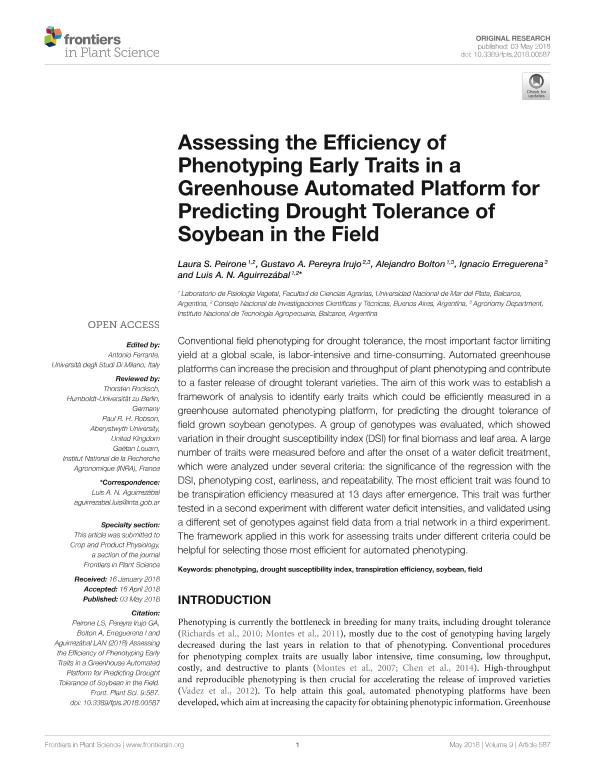Artículo
Assessing the efficiency of phenotyping early traits in a greenhouse automated platform for predicting drought tolerance of soybean in the field
Peirone, Laura Soledad ; Pereyra Irujo, Gustavo Adrian
; Pereyra Irujo, Gustavo Adrian ; Bolton, Alejandro
; Bolton, Alejandro ; Erreguerena, Ignacio Antonio; Aguirrezábal, Luis Adolfo Nazareno
; Erreguerena, Ignacio Antonio; Aguirrezábal, Luis Adolfo Nazareno
 ; Pereyra Irujo, Gustavo Adrian
; Pereyra Irujo, Gustavo Adrian ; Bolton, Alejandro
; Bolton, Alejandro ; Erreguerena, Ignacio Antonio; Aguirrezábal, Luis Adolfo Nazareno
; Erreguerena, Ignacio Antonio; Aguirrezábal, Luis Adolfo Nazareno
Fecha de publicación:
05/2018
Editorial:
Frontiers Media S.A.
Revista:
Frontiers in Plant Science
e-ISSN:
1664-462X
Idioma:
Inglés
Tipo de recurso:
Artículo publicado
Clasificación temática:
Resumen
Conventional field phenotyping for drought tolerance, the most important factor limiting yield at a global scale, is labor-intensive and time-consuming. Automated greenhouse platforms can increase the precision and throughput of plant phenotyping and contribute to a faster release of drought tolerant varieties. The aim of this work was to establish a framework of analysis to identify early traits which could be efficiently measured in a greenhouse automated phenotyping platform, for predicting the drought tolerance of field grown soybean genotypes. A group of genotypes was evaluated, which showed variation in their drought susceptibility index (DSI) for final biomass and leaf area. A large number of traits were measured before and after the onset of a water deficit treatment, which were analyzed under several criteria: the significance of the regression with the DSI, phenotyping cost, earliness, and repeatability. The most efficient trait was found to be transpiration efficiency measured at 13 days after emergence. This trait was further tested in a second experiment with different water deficit intensities, and validated using a different set of genotypes against field data from a trial network in a third experiment. The framework applied in this work for assessing traits under different criteria could be helpful for selecting those most efficient for automated phenotyping.
Archivos asociados
Licencia
Identificadores
Colecciones
Articulos(CCT - MAR DEL PLATA)
Articulos de CTRO.CIENTIFICO TECNOL.CONICET - MAR DEL PLATA
Articulos de CTRO.CIENTIFICO TECNOL.CONICET - MAR DEL PLATA
Citación
Peirone, Laura Soledad; Pereyra Irujo, Gustavo Adrian; Bolton, Alejandro; Erreguerena, Ignacio Antonio; Aguirrezábal, Luis Adolfo Nazareno; Assessing the efficiency of phenotyping early traits in a greenhouse automated platform for predicting drought tolerance of soybean in the field; Frontiers Media S.A.; Frontiers in Plant Science; 9; 5-2018; 1-14
Compartir
Altmétricas



